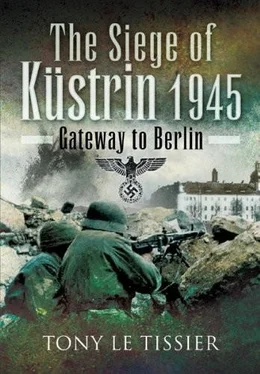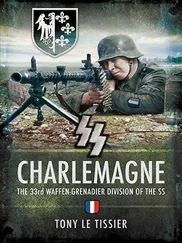I was detailed as a messenger and even given a light motorbike. The fuel lasted for three days, long enough in those temperatures. During this time my Volkssturm chief sent me late one evening in an easterly direction to Zirke, some 20 kilo-metres away, to find out where the Russians were. Over snow-covered roads, devoid of humanity and in icy temperatures I rode in total darkness, every so often stopping and restarting. Right on the edge of Zirke I turned round. I had carried out my task and could ride back in an easier frame of mind not having seen anyone.
On the 25th January we left Birnbaum and moved about 2 kilometres west to the Vorheide forester’s lodge. As a messenger I had to maintain contact with the organisations in Birnbaum and travelled to and fro. On one of these trips between the lodge and town, partly by footpath through the woods, I saw the first dead German soldiers. As the Russians had not got so far forward yet, they must have been shot by Polish partisans.
On the 27th January while on duty in the town I saw Russian tanks arrive. The town was cleared virtually without a fight and the bridge over the Warthe leading to the west was blown. On the same day we left the Vorheide lodge and marched about 10 kilometres to Waitze, where we accommodated ourselves in the local school with the veteran Volkssturm men.
On the morning of the 29th January, while being allocated to the defence of an imaginary front line, we received our first artillery or tank fire. Our Volkssturm veterans with their experience of the First World War gave us some very helpful rules that later were life-saving. No one was injured and so we took up our positions along the road to Birnbaum. We could hear the noise of tanks all day and once saw a group of Russians in the distance.
At nightfall our comrades to the west came back to join us bringing the news that the Russians had entered Waitze, and that we were cut off. Led by our old Volkssturm men, who were familiar with the area, we went in single file in a wide curve to the north of Waitze through deeply snowed woods.
Unmolested we came to the Waitze–Schwerin (Warthe) road leading west, which we followed all night. Dead tired, with blisters on our feet, we reached Schwerin at dawn. There the barracks offered us the chance of having a shower, breakfast, a change of clothing and sleep. We felt safe, let the relief overcome us, but were hardly asleep before we were woken up again at noon by enemy artillery fire.
The whole, but nevertheless meagre garrison appeared to have been completely taken by surprise. Disorganised, they fled the barracks and town and, from necessity, we joined in this disorder with the proviso of reporting to specific offices in Küstrin, 65 kilometres away. In view of our previous strenuous journey and the varying individual abilities to march, there was no question of marching in formation. We would have to see how we would get to Küstrin. So, we were on the move once more, now on crowded roads among the fleeing civilian population with and without horses and carts, and among them groups of Wehrmacht stragglers, some with vehicles. The clear thunder of the guns drove us forward.
Here we lost sight of some of the Birnbaum schoolboys. I only met five of them again. Whether the remainder reached Küstrin or were overrun by the Russian armoured spearheads, I cannot say. I have not heard of any of them, and the same applies to the old Volkssturm men. I never saw them again.
After marching a few kilometres, there came an opportunity of riding on the back of a slowly moving Wehrmacht truck for my fellow schoolboy Manni Roeder from the 6th Form and me, as we were marching along together. At first the crew tried to stop us jumping on, but then saw how young we were and let us on. Unfortunately this truck only went as far as Kriescht, 30 kilometres from Küstrin. There we were able to obtain some food. Looking for another means of continuing we found a train about to leave Kriescht station. Although it was packed with refugees, we managed to find places to sit and reached Küstrin late in the afternoon. [13]
Others were less fortunate, as Councillor Staercke of Güstebiese, downstream from Küstrin on the east bank of the Oder, reported:
I had been in communication with both [the village mayor] Habermann and [Ortsgruppenleiter Fritz] Lorenz about the evacuation until the last moment. I was also in communication with the young commandant during the German occupation. All three said that the civilian population would get the news in time. When asked about the alleged or actual Russian presence near Bärwalde all three were uncomfortable and said that the departure of the population was only possible with their permission. No information or instructions then resulted, as both the Ortsgruppenleiter and the mayor fell into the hands of the Russians. [14]
Chapter Three
Defence Preparations
Küstrin was declared a fortress on 25 January 1945. At that time the garrison consisted of depot, training and convalescent infantry, plus engineer and artillery units with a few anti-tank weapons but no air defences. The newly named fortress commandant was 50-year-old Major-General Adolf Raegener, holder of the Knights’ Cross and a soldier since the First World War. He began by incorporating the local Volkssturm and police resources into his garrison, having nothing else to fall back on. Above all, General Raegener needed heavy weapons. Flak guns had been assigned to him from the Berlin area, but would they arrive in time?
Under the circumstances, the most useful role for the fortress, which Clausewitz once described propitiously as a ‘place of refuge for a weak or unfortunate corps’, was to provide secure river crossings for those army elements still east of the Oder and not withdrawing upon Frankfurt. Raegener’s men would have only a few days in which to prepare if the Soviet advance was not delayed by the old border fortifications 70 kilometres east of the town. This was in any case a very vague hope, as all the troops that had been sent there were of equally limited fighting ability, such as the Volkssturm companies of the first levy from Küstrin, Neudamm and Königsberg/Neumark that were being transported by rail that day to Trebisch, 15 kilometres south-east of Landsberg.
Preparations for any sort of defence of the town appeared almost impossible with the existing materiel and personnel available, especially for the Neustadt. In contrast to the Altstadt, it was unhindered by walls and ditches and within a few decades it had developed into a significantly important part of the town, extending over a kilometre beyond the 75-year-old Neues Werke, the small fort that had been built to protect the railway station. Housing and industrial buildings had long since extended along the river as far out as the boundaries of the Drewitz and Warnick villages. A town bus service had connected the districts until the fuel supply began to run out, and then the buses were fitted to run on town gas supplied from tanks fitted on the coach roofs.
This extension of the Neustadt, with its new infantry barracks, a country pub and its sports stadium erected in the late 1920s, came up against dense woodland in the north-east. Here the land began to climb steeply and the Zorndorfer Berg, the horror of all cyclists, led over 2 kilometres to a high plateau above the Oder-Warthe valley bottom. This plateau exceeded the town in height by about 50 metres and offered, together with a fort in the centre on the road to Zorndorf, an outer defensive ring if only it could be adequately manned. But the garrison was not in a position to do this from its own resources. It was indeed doubtful if the Neustadt bridgehead would be able to hold up to the first energetic attack, however wide or short the front line stretched. Military necessity therefore required that it be held only as long as the railway station and Warthe bridges were needed for the withdrawal. Beyond that there were no reasonable grounds for keeping a considerable proportion of the troops in an unsuitable position. A sufficiently strong Altstadt garrison to bar the river crossings to the enemy would suffice with less risk. But decisions of this nature were no longer to be made according to tactical and strategic considerations. [1]
Читать дальше












